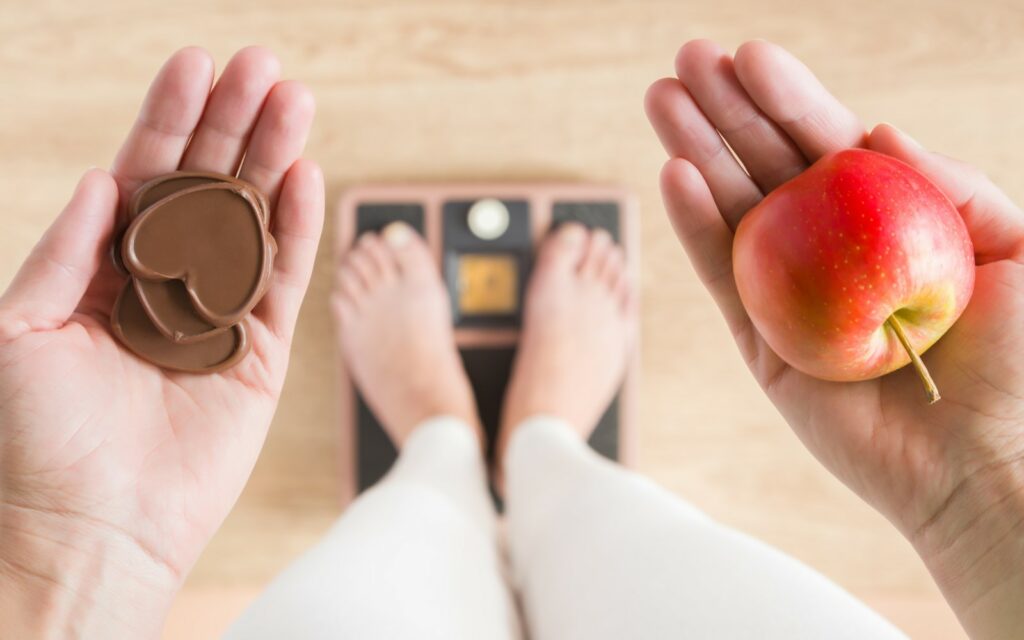
Not seeing the desired results from your weight loss endeavours lately? Despite cutting back on calories, is the scale refusing to budge? Wondering why?
Your body might be undergoing metabolic adaptation, where it gradually burns fewer calories in response to reduced food intake. This natural defence mechanism helps safeguard your body against starvation.
However, if your body enters this state, achieving weight loss and sustaining results becomes more challenging.
Fortunately, there are strategies to overcome metabolic adaptation and reignite your weight loss journey.
By integrating a balanced approach of diet, exercise and lifestyle adjustments, you can kickstart your progress and attain your desired results.
Maximising Calories Out
When it comes to achieving and maintaining fitness while managing weight, there’s one factor that reigns supreme: calories out.
The concept of ‘calories out’ is often overlooked but plays a crucial role in weight loss, often causing many to fall short of their goals. Achieving weight loss requires maintaining a caloric deficit over time. However, many individuals attempt to create this deficit solely by reducing calorie intake, which can eventually lead to metabolic adaptation.

Achieving weight loss requires burning more calories than you consume, regardless of the quality of your diet.
To optimize calorie expenditure, focus on maximizing four key components. Doing so not only facilitates fat loss but also enables you to sustain your progress over time.
Basal Metabolic Rate (BMR)
BMR represents the calories your body expends at rest to maintain essential bodily functions. It constitutes over 60% of your daily calorie expenditure. [1]
BMR is influenced more by lean muscle mass than by fat. Consequently, men typically have higher BMRs than women and BMR tends to decline with age.
Thermic Effect Of Feeding (TEF)
TEF represents the energy expended by your body during the digestion and absorption of food.
This process typically accounts for approximately 10% of your daily calorie expenditure and varies based on the composition of the foods consumed.
For example, protein elicits a greater TEF compared to carbohydrates or fats due to the additional energy needed for its digestion and absorption. The thermic effect of protein ranges from 20-30%, while for carbohydrates and fats, it’s approximately 5-10% and 0-3%, respectively. Consequently, protein ultimately provides the lowest net calories, followed by carbohydrates and fats. Even in situations of caloric surplus, consuming ample protein makes it more challenging to accumulate fat. [2]
Refined and processed foods typically exhibit a lower TEF compared to whole, unprocessed foods.
Non-Exercise Activity Thermogenesis (NEAT)
NEAT encompasses the energy expended during daily activities that are not considered formal exercise, such as walking around the house, fidgeting, or even shivering.
This component of calories out makes up a large part of the calories you burn daily, but can vary widely depending on your job, lifestyle and habits.
For instance, while some individuals might expend an additional 200 calories per day through NEAT, others could burn as much as 1,000 calories solely from these activities.
NEAT can significantly influence whether you lose or gain weight. A more active lifestyle translates to burning more calories effortlessly.
If your job requires little movement, incorporating more informal activities into your routine can be beneficial. Conversely, if you have a physically demanding job, you may not need to focus as much on conscious exercise.
Exercise Activity Thermogenesis (EAT)
As expected, EAT refers to the energy expended through structured exercise like running, weightlifting, or participating in sports.
Surprisingly, while EAT typically constitutes only a small portion of daily calorie expenditure, it still plays a significant role in weight loss.
Metabolism
Metabolism is the intricate process through which your body converts food into energy, and monitoring Total Daily Energy Expenditure (TDEE) is vital. TDEE encompasses the four components mentioned earlier.
Calories that don’t get burned throughout the day may become stored as fat, which is much harder to burn off.
Weight Loss Is A Matter Of Caloric Deficit

You can think of shifts in weight like a math equation.
Weight changes can be simplified as a mathematical equation: if the calories you burn exceed those you consume, weight loss occurs; conversely, weight gain happens when calorie intake surpasses expenditure. When these two sides balance, your weight remains stable.
To shed weight, generating a caloric deficit is key, achieved by consuming fewer calories than your TDEE. This could involve straightforward strategies like reducing calorie intake or incorporating short walks into your daily routine. Additionally, formal exercise sessions can contribute to this deficit.
Your body has a natural survival mechanism to prevent starvation, which can lead to a reduction in TDEE and increased hunger over time. Maintaining a high metabolism or TDEE is essential for sustained fat loss and long-term weight management.
Here’s how:
Additional Ways To Maximize Calories Out
Build More Muscles
Having more muscle mass can elevate your BMR. As muscles require calories for growth, this leads to an increase in calorie expenditure. Consequently, your BMR experiences a slight uptick, resulting in a beneficial cycle of calorie burning and muscle growth.
You don’t need to aim for bodybuilder status to reap the rewards. Even adding a modest amount of muscle can have a significant impact and assist in maintaining a healthy weight.
Move Throughout The Day
Prolonged periods of sedentary behaviour, whether sitting, standing, or lying down, result in minimal calorie expenditure. Individuals who spend extended periods in sedentary activities often experience slower metabolisms compared to those leading more active lifestyles, increasing their susceptibility to obesity.
Extended periods of sitting can have detrimental effects on your metabolism, as studies indicate.[3] If you have a desk job, it’s advisable to take frequent breaks to incorporate activities like squats to counteract the effects of prolonged sitting.
Although it might not seem significant initially, the benefits will compound over time.
Integrating brief periods of activity like stretching, short walks, push-ups, or even a quick yoga session can counteract the effects of prolonged sitting.
These small bursts of movement are a subtle yet effective strategy for burning fat.
Cold Exposure – Burn Calories And Increase Brown Fat
Consistent exposure to cold temperatures can rev up your metabolism and aid in weight loss. Your body expends extra energy to sustain its regular core temperature, gradually prompting the development of brown fat. Don’t be alarmed; brown fat is beneficial.
Brown fat can be likened to fat that actively burns calories instead of hoarding them like white fat does. The greater your brown fat reserves, the more calories you can torch.
Cold exposure is the catalyst for transforming white fat into brown fat and has the potential to elevate brown fat deposits by up to 42%. [4]
Exposure to cold can also enhance mitochondrial function, which serves as the powerhouse for your cells, crucial for metabolic processes.
Push Your Brain

Your brain, one of the most active organs in your body, consumes approximately 20% of the calories you burn daily, solely to support its functions.
To enhance your metabolism, engaging in mentally stimulating activities is highly beneficial.
Research indicates that individuals who regularly challenge their brains with such activities are less likely to encounter age-related cognitive decline. [5]
To maintain a high metabolism and sharp cognitive function, it’s essential to exercise your brain alongside your physical workouts. Engage in activities like solving puzzles, reading complex books, and acquiring new skills to keep your mind active and agile.
Exercise
Engaging in exercise not only burns more calories compared to sedentary activities but also promotes muscle growth, especially with workouts like weight lifting or High-Intensity Interval Training (HIIT).
HIIT involves brief bursts of intense, explosive exercises alternated with short rest periods. It effectively targets different muscle groups and provides a dual benefit of enhancing muscle mass and cardiovascular fitness.
Weight lifting primarily aims to enhance muscle mass and strength. While it may not offer the same cardiovascular advantages as HIIT or cardio workouts, it promotes rapid muscle development.
Cardiovascular training, such as running or cycling, primarily enhances cardiovascular fitness and endurance. Although it may not lead to muscle growth as significantly as weight lifting or HIIT, it still contributes to muscle development.
As previously noted, muscle building requires energy and calories, which is why weight lifting and HIIT are effective for creating a caloric deficit. Even after you finish your workout, your body continues to burn calories throughout the day.
Strive to incorporate at least 30 minutes of strength-building exercises into your daily routine. Not only will this enhance your overall well-being, but it will also help shed unwanted fat and maintain your progress over time.
Disrupt Metabolic Adaptation
If you’ve been on a diet for an extended period, you might have observed that shedding weight becomes increasingly challenging.
This is due to your body adjusting to the reduced calorie intake, resulting in the burning of fewer calories. Essentially, your metabolism decelerates to conserve energy.
To counteract this metabolic adaptation, consider periodically increasing your caloric intake, a practice commonly referred to as a refeed or diet break.
During a refeed, consuming more calories for 1-2 days can rev up your metabolism and aid in overcoming the weight loss plateau. [6]
Research indicates a comparable reversal of metabolic adaptation during a diet break, typically lasting 1-2 weeks within longer-term dietary regimens. [7]

Boost Mitochondrial Function
Mitochondria serve as the powerhouses of our cells, responsible for generating the energy essential for cellular functions.
However, with age, mitochondrial function can decline, resulting in a decreased metabolism and a heightened susceptibility to weight gain.
kApex is a sophisticated fusion of digestive enzymes meticulously crafted to facilitate the breakdown of fats and proteins. Additionally, it incorporates various other components that enhance mitochondrial function and promote weight loss.
Another biohack worth exploring is red light therapy, a form of light therapy that utilizes red and near-infrared light to enhance mitochondrial function. I’ve personally incorporated red light therapy into my routine for several years now and have experienced its benefits firsthand.
Conclusion
Boosting your metabolism is arguably the most critical element of weight loss, yet it’s often overlooked in discussions about shedding pounds.
Chances are, you’re not achieving the lasting results you desire with your current dietary regimen, weight loss gimmick, or exercise routine because your body’s innate survival mechanisms kick in, suppressing your metabolism in the process.
With a grasp of how to optimize your metabolism, you can ensure that your efforts in the gym or kitchen yield tangible results, whether it’s shedding fat or building muscle.
Keep in mind that while healthy eating and exercise are crucial, prioritizing the optimization of calories out can provide you with an advantage in achieving and sustaining your fitness objectives.
- Mendelson SD. Factors that contribute to metabolic syndrome. In: Metabolic Syndrome and Psychiatric Illness. Elsevier; 2008:11-26.
- Antonio J, Peacock CA, Ellerbroek A, Fromhoff B, Silver T. The effects of consuming a high protein diet (4.4 g/kg/d) on body composition in resistance-trained individuals. J Int Soc Sports Nutr. 2014;11(1):19. doi:10.1186/1550-2783-11-19
- Owen N, Healy GN, Matthews CE, Dunstan DW. Too much sitting: the population health science of sedentary behavior. Exerc Sport Sci Rev. 2010;38(3):105-113. doi:10.1097/JES.0b013e3181e373a2
- Cool temperature alters human fat and metabolism. National Institutes of Health (NIH). Published May 14, 2015. Accessed August 2, 2022. https://www.nih.gov/news-events/nih-research-matters/cool-temperature-alters-human-fat-metabolism
- Seider TR, Fieo RA, O’Shea A, Porges EC, Woods AJ, Cohen RA. Cognitively engaging activity is associated with greater cortical and subcortical volumes. Front Aging Neurosci. 2016;8. doi:10.3389/fnagi.2016.00094
- Escalante G, Campbell BI, Norton L. Effectiveness of diet refeeds and diet breaks as a precontest strategy. Strength Cond J. 2020;42(5):102-107. doi:10.1519/ssc.0000000000000546
- Byrne NM, Sainsbury A, King NA, Hills AP, Wood RE. Intermittent energy restriction improves weight loss efficiency in obese men: the MATADOR study. Int J Obes (Lond). 2018;42(2):129-138. doi:10.1038/ijo.2017.206
Share:

BIOptimizers
Become A Biologically Optimized Human

Social Media
Most Popular
Diet and Mental Health
Understanding Low Stomach Acid and How Betaine HCl Can Help
Vitamins and Supplements to Help with Deep Sleep
Subscribe To Our Weekly Newsletter
Categories
Related Posts
Are Sweet Proteins A Healthy Substitute For Sugar?
Excess sugar is linked to health issues like weight gain and blood sugar imbalances. Now imagine enjoying sugar’s taste without the calories or additives—sweet proteins offer this unique advantage. Naturally derived from plants, they’re intensely sweet without extra calories and spiking your blood sugar. First-generation artificial sweeteners, and even natural options like stevia, have a bitter aftertaste. Recent
Diet and Mental Health
Estimates now show us that one in five people struggle with mood and mental health issues, making it a growing public health concern.[1] They can affect how people feel, think, and function. Despite advances in treatment, many people still struggle with symptoms every day. Commonly seen alongside these issues are poor diet, increasing nutrient deficiencies, and
Understanding Low Stomach Acid and How Betaine HCl Can Help
If you’ve ever felt a burning sensation in your chest or struggled with bloating and indigestion after eating, you might think excess stomach acid is to blame. I used to believe the same, treating every bout of discomfort with antacids and hoping for relief. But what if the real issue was too little stomach acid?
Vitamins and Supplements to Help with Deep Sleep
Sleep quality, especially deep and REM sleep, is unarguably one of the most important things to optimize, whether you want to maximize aesthetics, performance, or health. Matt learned this the hard way when he could not feel rested no matter how much he slept. He fell asleep just fine but always woke up groggy even after



